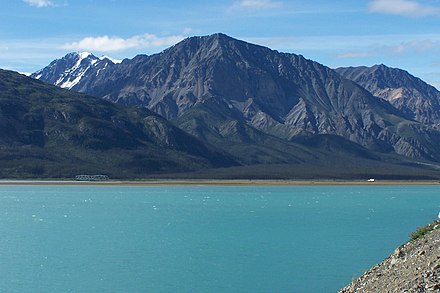Kluane National Park - national park in Canada
Kluane National Park and Reserve is composed of two parts: a national park and a reserve in the southwest corner of Yukon. It is part of the Kluane-Wrangell-St. Elias-Glacier Bay-Tatshenshini-Alsek UNESCO World Heritage Site.
Understand
Kluane National Park Reserve was established in 1972, and covers , making it larger than El Salvador.
Contact the park office at +1-867-634-7250 ext 216, or email
History
Kluane National Park was established in 1972 in the southwestern corner of the Yukon, near Haines Junction.
The bi-national Kluane-Wrangell-St. Elias-Glacier Bay-Tatshenshini-Alsek park system comprising Kluane, Wrangell-St Elias, Glacier Bay and Tatshenshini-Alsek parks, was declared a UNESCO World Heritage Site in 1979 for the spectacular glacier and icefield landscapes as well as for the importance of grizzly bears, caribou and Dall sheep habitat.
Kluane National Park lies within the traditional territories of the Champagne and Aishihik First Nations and Kluane First Nation who have a long history of living in this region. Through their respective Final Agreements with the Canadian Government, they have made into law their rights to harvest in this region.
Landscape
The reserve includes the highest mountain in Canada, Mount Logan (5,959 metres or 19,551 feet) of the Saint Elias Mountains. Mountains and glaciers dominate the park's landscape, covering 83% of its area. The rest of the land in the park is forest and tundra—east of the largest mountains and glaciers—where the climate is colder and drier than in the western and southern parts of the park. Trees grow only at the park's lowest elevations. The primary tree species are white spruce, balsam poplar and trembling aspen.
Flora and fauna
The flora of Kluane National Park consists of a blend of pacific, arctic and maritime flowers. Some examples are: moss campion, mountain heather, fireweed, purple saxifrage and more.
Mammalian species that inhabit this park include wolf packs, coyote, mink, lynx, river otter, caribou, Alaskan moose, muskrat, snowshoe hare, marmot, red fox, Dall sheep, beaver, wolverine, mountain goat, and arctic ground squirrel. This park contains about 120 species of birds, including the rock ptarmigan and the golden and bald eagles.
Climate
Get in
Kluane National Park is 160 km west of the territorial capital Whitehorse. The town of Haines Junction is a convenient base for exploration. From there, Haines Highway leads south and the Alaska Highway leads north along the park’s eastern edge, with access to hiking and camping.
The park’s interior is generally accessible only via a flightseeing tour or on a serious mountaineering or ski touring expedition.
By car
Visitors can reach Haines Junction by driving 160 km west of Whitehorse on the Alaska Highway (Highway 1), or by driving 249 km north of Haines, Alaska on the Haines Road (Highway 3). From Anchorage or Fairbanks, visitors can drive to Kluane National Park by connecting with the Alaska Highway and following it south to Thachäl Dhäl (Sheep Mountain).
The Alaska Highway and the Haines Highway parallel the park boundary in the Haines Junction area. Visitors are able to drive into the park at Kathleen Lake and Thachäl Dhäl (Sheep Mountain). However, most access into the park is by foot, raft, or skis.
By air
Whitehorse is served by daily commercial flights originating in Vancouver. There are also regular flights from Calgary/Edmonton, Kelowna, Ottawa/Yellowknife, Fairbanks (summer only) and Frankfurt (summer only).
By ferry
Many visitors take the Alaska Marine Highway ferry system to Haines, Alaska or Skagway, Alaska. From Haines Alaska, visitors can reach Haines Junction by driving 249 km north on the Haines Road (Highway 3). From Skagway, you can drive 179 km north to Whitehorse on the South Klondike Highway (Highway 2), then west 160 km on the Alaska Highway (Highway 1) to Haines Junction.
Fees and permits
Fishing per permit:
- Daily $ 9.80
- Annual $ 34.30
Get around
See
- Mount Logan, 60.567222°, -140.402778°. Canada's highest mountain with an elevation of 5959 metres (19,551 ft). 2022-05-28
Do
- A day-use area with boat launch, picnic facilities and campground is located at Kathleen Lake, and is operated from mid-May to mid-September.
- Hiking is a popular activity on trails such as St. Elias Lake, Mush Lake Road, Shorty Creek, Cottonwood, Rock Glacier, King's Throne, Kokanee, Auriol, Dezadeash River Trail, Alsek Trail, Sheep Creek Trail, Bullion Plateau Trail, Slims West or Soldiers Summit.
- Rafting on the Alsek River (a Canadian Heritage river).
- Mountain biking on old mining roads, horseback riding through the Alsek Pass.
- Boating on Kathleen Lake and Mush Lake.
- Fishing for lake trout, Arctic grayling, rainbow trout, northern pike and sockeye salmon.
- Flightseeing. Several local companies offer flightseeing tours that take visitors deep into the park’s untouched interior. Get a high-altitude view of the Icefield Ranges, home to Canada’s highest peaks and largest icefields, from a prop plane or helicopter. Some tours touch down in the midst of the icefields, enabling visitors to stay and explore for a few hours or a few days. 2018-03-24
Buy, eat, and drink
There are no facilities in the park.
Sleep
Lodging
Camping
- Kathleen Lake Campground (primitive, no showers), per site, per night: $15.70
- Campfire permit per site, per day: $8.80
Backcountry
Backcountry/mountaineering permit per person (adults and youth):
- Overnight/Annual: $9.80/$68.70
Landing permit per party/landing: $29.40
Stay safe
Go next
Related: UNESCO World Heritage List

